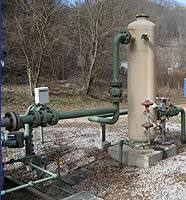Quick Facts:
- Gathering pipelines, with specific exceptions, are regulated by PHMSA under the regulations found in 49 CFR Parts 192 and 195.
Overview
Gathering lines are defined as:
- For hazardous liquids, a pipeline 219.1 mm (8 5/8 in) or less in nominal outside diameter that transports petroleum from a production facility (49 CFR 195.2); and
- For natural gas, a pipeline that transports gas from a current production facility to a transmission line or main (49 CFR 192.3) as determined using an industry standard (49 CFR 192.8).
Plainly speaking, gathering lines are those pipelines that are used to transport crude oil or natural gas from the production site (wellhead) to a central collection point. They generally operate at relatively low pressures and flow, and are smaller in diameter than transmission lines. Like oil and gas transmission pipelines, gathering lines are regulated by the U.S. Department of Transportation, Pipeline and Hazardous Materials Safety Administration (PHMSA). Historically, those gathering lines that were regulated were required to comply with the respective regulations for transmission pipelines, as found in 49 CFR Parts 192 & 195. That approach is now changing somewhat, as described below.
The pipeline safety regulations provide exceptions and further clarification for both oil and gas gathering pipelines regarding the scope of what is covered under the regulations. The exceptions and clarifications are pertinent to gathering pipelines located in sparsely populated areas. For crude oil gathering lines, the exceptions relate to defined populated areas.

If an onshore crude oil gathering line runs from point A to point D, passing through the area within City A’s limits, the section represented by point B to point C would be regulated. The sections running between points A-B and C-D would be non-regulated. The regulated sections would have to meet the requirements of 49 CFR Part 195.
Redefining the regulation of gathering pipelines
Until recently, the portions of gas gathering pipelines that were regulated were determined using a similar approach. This resulted in some portions of gas gathering lines that pass close to areas where people work or live not being regulated (because they were in “rural” areas), while some portions where an accident would likely not affect people were regulated only because they were in cities, towns or other designated areas. Congress directed that DOT more clearly define which portions of gathering pipelines should be regulated.

PHMSA revised its regulations concerning gas gathering pipelines in response to this mandate on March 15, 2006. The new requirements incorporate an industry standard, American Petroleum Institute Recommended Practice 80 (API RP 80), to better define which portions of the natural gas pipeline network are considered “gathering” pipelines. The revision also changed how a pipeline operator must determine which of its gas gathering pipelines are subject to regulation, i.e., which are “regulated gathering lines.” This is done using criteria that determine when a gas gathering pipeline is close enough to a number of homes or to areas/buildings where people congregate, that an accident on the pipeline could impact them. Offshore gas gathering pipelines and high-pressure onshore lines meeting these criteria must meet all requirements of 49 CFR Part 192 applicable to gas transmission pipelines. Onshore gas gathering pipelines that operate at lower pressures must comply with a subset of these requirements specified in 49 CFR 192.9.
PHMSA revised its regulations concerning hazardous liquid gathering lines on June 3, 2008. Under this change, gathering lines in non-rural areas remain regulated as before. Gathering lines in rural areas are subject to regulation if they are in or within ¼ mile of an unusually sensitive area (USA). A USA is an area that includes a drinking water source or ecological resource area that is unusually sensitive to environmental damage from a hazardous liquid pipeline release (see 49 CFR 195.6).
Where can I get more information on gathering lines?
- Documents related to PHMSA’s reconsideration of gathering pipeline regulation are available for download from Regulations.gov. Enter the Docket Number into the “Enter keyword or ID” box, PHMSA-1998-4868 for the Gas Gathering Lines docket or PHMSA-RSPA-2003-15864 for the Liquid Gathering Lines docket, and press “Search.”
- Public meetings on the safety regulation of gas and liquid gathering lines were held on November 19-20, 2003 in Austin, TX and December 16-17, 2003 in Anchorage, AK. Complete transcripts of these meetings, along with submitted comments, are among the documents available in the dockets.
- 49 CFR Subchapter D, Pipeline Safety, Parts 192 & 195
- PHMSA has compiled frequently asked questions (FAQs) intended to clarify, explain, and promote better understanding of the regulations for onshore gas gathering pipelines.
Date of Revision: 01122018
